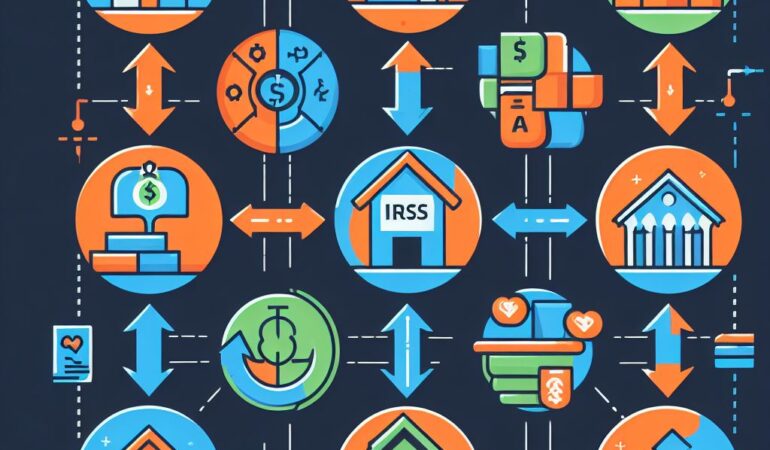Are you ready to dive into the intricate world of IRS 1031 exchange rules? Get ready to navigate the labyrinth of regulations and deadlines with this beginner’s guide.
From understanding the basics to identifying eligible properties, this article will equip you with the knowledge needed for a successful exchange.
Discover the tax implications and benefits that await you on this exciting journey.
So grab your map and let’s embark on this 1031 exchange adventure together.
Key Takeaways
- A 1031 exchange is a tax-deferral strategy for postponing capital gains taxes on the sale of an investment property.
- The properties involved in a 1031 exchange must be of like-kind.
- There are strict timelines and deadlines imposed by the IRS for identifying and acquiring replacement properties.
- Completing a 1031 exchange offers tax deferral, wealth accumulation, portfolio diversification, and estate planning advantages.
What Is a 1031 Exchange
Are you wondering what exactly a 1031 exchange is? Well, let’s dive into the details of this tax-deferral strategy that allows you to postpone paying capital gains taxes on the sale of an investment property.
A 1031 exchange, also known as a like-kind exchange, refers to a provision in the Internal Revenue Code (IRC) that allows you to defer the recognition of capital gains or losses when you exchange one investment property for another. This powerful tool can be used by individuals, partnerships, corporations, or trusts, as long as the properties being exchanged are held for investment or business purposes.
To qualify for a 1031 exchange, the properties involved must be of like-kind, which means they share a similar nature and character, even if they differ in quality or grade. The IRS provides guidelines on what kinds of properties are considered like-kind, but generally, real estate can be exchanged for other real estate, such as residential properties for commercial properties or undeveloped land for rental properties. Personal properties, like your primary residence or stocks, don’t qualify for a 1031 exchange.
It’s important to note that a 1031 exchange isn’t a tax-free transaction but rather a tax-deferral strategy. By deferring the capital gains taxes, you can reinvest the proceeds from the sale into a new property, potentially allowing you to grow your investment portfolio over time.
Understanding the IRS Rules for a Successful Exchange
To successfully navigate a 1031 exchange, it is essential that you familiarize yourself with the IRS rules and guidelines. These rules are designed to ensure that the exchange is a legitimate transaction and not simply a way to avoid paying taxes. Understanding the IRS rules will help you make informed decisions and avoid any potential pitfalls or penalties.
Here is a table summarizing the key IRS rules for a successful exchange:
| Rule | Description |
|---|---|
| Like-Kind Property | The property you exchange must be of the same nature or character. For example, you can exchange a residential rental property for another residential rental property, but not for a commercial property. |
| Identification Period | You have 45 days from the date you transfer the relinquished property to identify potential replacement properties. You can identify up to three properties, regardless of their value. |
| Exchange Period | You must acquire the replacement property within 180 days of transferring the relinquished property. The exchange period includes the 45-day identification period. |
| Qualified Intermediary | You must use a qualified intermediary to facilitate the exchange. The intermediary holds the funds from the sale of the relinquished property and uses them to acquire the replacement property. |
Identifying Eligible Properties for a 1031 Exchange
Start by identifying potential replacement properties that meet the criteria for a 1031 exchange. This is a crucial step in ensuring a successful exchange and maximizing your tax benefits.
To help you in this process, here are five key factors to consider when identifying eligible properties:
- Location: Look for properties in areas with strong economic growth and potential for appreciation. Consider factors like job growth, population trends, and infrastructure development.
- Property Type: Determine the type of property that aligns with your investment goals. It could be residential, commercial, industrial, or even vacant land. Each has its own set of advantages and risks.
- Value: Ensure that the fair market value of the replacement property is equal to or greater than the relinquished property. This is important to satisfy the IRS requirement of ‘equal or up’ in the exchange.
- Use: The replacement property must be used for productive purposes, such as rental or business operations. Personal use properties, like vacation homes, don’t qualify for a 1031 exchange.
- Timing: Keep in mind the strict timelines imposed by the IRS for identifying and acquiring replacement properties. You have 45 days to identify potential properties and 180 days to complete the exchange.
By considering these factors, you can narrow down your options and select replacement properties that meet the IRS criteria for a 1031 exchange.
Remember to consult with a qualified intermediary and tax advisor to ensure compliance with all regulations and maximize your tax benefits.
Timelines and Deadlines for Executing a 1031 Exchange
To ensure a successful 1031 exchange, it’s crucial to understand and adhere to the strict timelines and deadlines set by the IRS.
The first important deadline to keep in mind is the identification period, which begins on the day of the sale of your relinquished property and lasts for 45 calendar days. During this time, you must identify potential replacement properties in writing to your Qualified Intermediary (QI).
There are three identification rules you must follow: the Three-Property Rule, the 200% Rule, and the 95% Rule. These rules dictate the number and value of replacement properties you can identify. It’s important to carefully consider your options and ensure that your identification is accurate and within the rules.
The second crucial deadline in a 1031 exchange is the exchange period, which begins on the day of the sale of your relinquished property and lasts for 180 calendar days. During this time, you must acquire one or more replacement properties. It’s important to note that both the identification and exchange periods run concurrently, meaning that you must complete the acquisition of your replacement property within the 180-day timeframe.
Understanding and adhering to these timelines and deadlines is essential to the success of your 1031 exchange. Failure to meet these deadlines may result in disqualification of your exchange and the realization of taxable gain.
Now that you understand the timelines and deadlines involved in a 1031 exchange, let’s move on to discussing the tax implications and benefits of this strategy.
Tax Implications and Benefits of a 1031 Exchange
You can benefit from a 1031 exchange by deferring taxes on your capital gains. This tax strategy allows you to reinvest the proceeds from the sale of one property into the purchase of another like-kind property, while deferring the capital gains tax that would normally be due.
Here are five key tax implications and benefits of a 1031 exchange:
- Tax deferral: By completing a 1031 exchange, you can defer paying taxes on your capital gains, allowing you to keep more money invested in your new property.
- Wealth accumulation: With the ability to defer taxes, you have the opportunity to grow your wealth by reinvesting the full amount of your capital gains into a new property.
- Portfolio diversification: A 1031 exchange enables you to diversify your real estate portfolio by exchanging into different types of properties or locations, without incurring immediate tax consequences.
- Estate planning advantages: By utilizing a 1031 exchange, you can potentially pass on a larger real estate portfolio to your heirs, as the taxes on the capital gains are deferred until the property is eventually sold.
- Simplified tax reporting: While a 1031 exchange involves specific rules and requirements, the process of reporting your taxes remains relatively straightforward, as the exchange isn’t considered a taxable event.
Frequently Asked Questions
Can Personal Property, Such as Artwork or Vehicles, Be Exchanged Under a 1031 Exchange?
Yes, you can exchange personal property like artwork or vehicles under a 1031 exchange. However, it must meet certain criteria, such as being held for business or investment purposes and being of like-kind.
Are There Any Restrictions on the Location of the Replacement Property in a 1031 Exchange?
There are restrictions on the location of the replacement property in a 1031 exchange. It must be within the United States, and it can’t be your personal residence or a property primarily used for personal purposes.
Is It Possible to Simultaneously Sell One Property and Purchase Multiple Replacement Properties in a 1031 Exchange?
Yes, you can simultaneously sell one property and purchase multiple replacement properties in a 1031 exchange. This strategy allows you to diversify your investments and potentially increase your overall returns.
What Happens if the Identification Deadline for Replacement Property in a 1031 Exchange Is Missed?
If you miss the identification deadline for replacement property in a 1031 exchange, you will no longer be able to defer your capital gains taxes, and you will be responsible for paying taxes on the sale.
Are There Any Exceptions to the Requirement of Like-Kind Properties in a 1031 Exchange?
There’s a big exception to the like-kind rule in a 1031 exchange. It’s called the “boot” and it means you might have to pay taxes on any cash or property you receive that isn’t like-kind.




